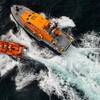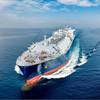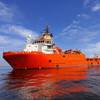The Tognum Group will be showcasing its new-generation, MTU-branded EPA Tier 4i-compliant Series 2000 and Series 4000 diesel engines for oil and gas applications at OTC, the offshore industry trade show taking place May 2-5, 2011 in Houston, Texas (booth 5563). Both engines are able to meet EPA Tier 4 interim emissions requirements solely through the use of in-engine technology. No aftertreatment is necessary.
These Tier 4i-compliant engines lay the foundations for the EPA’s Tier 4 final regulations which will apply from 2015. MTU’s goal is to find an in-engine solution to meet this even more stringent requirement. The new generation of the Series 2000 engines for oil and gas applications covers the 858 to 1,163 kW (1,150 to 1,560 hp) power range and is used in various mechanical and electric drive applications in the exploration and production of oil and natural gas, for example in pumps, blenders, drill rigs, fracturing, hydration and nitrogen pump applications. Series 2000 engines consume less fuel than their predecessors – up to 10 percent – despite the considerably tighter emissions values. Their performance is constant up to heights of 3,100 meters (10,170 ft) and their performance maps are optimally adjusted to suit the requirements of oil and gas applications. The life-cycle costs are lower than for the previous generation. That is a result not only of the fuel-saving factor, but also of the longer maintenance intervals for individual components. Series 2000 engines will be introduced onto the market in stages from mid-2011 as 12- and 16-cylinder units.
The new generation of the Series 4000 engine covers the 1,678 to 1,864 kW (2,250 to 2,500 hp) power range with a 12-cylinder version and is suitable for driving hydraulic fracturing or “frac” pumps. These use special fluids under high pressure to fracture rocks to increase the volume and improve the efficiency in the recovery of petroleum and natural gas reserves. Series 4000 engines boast an optimum power-to-weight ratio, allowing mobile “frac fleets” – truck-mounted pump units for the oil and gas production – to stay within the maximum weight limits for highway transit. That not only brings a high degree of operational flexibility, but saves the user license charges and logistics expense. Furthermore, the engines consume up to 5 percent less fuel, despite the considerably tighter emissions values, and they provide superior torque performance compared to their predecessors. Their performance remains constant up to heights of around 4,000 meters (13,120 ft) without derate.



![MTU Series 2000 diesel engines are able to meet EPA Tier 4i emissions requirements without aftertreatment. [Pictured: 12V 2000 CX6/] Images courtesy Tognum Group](https://images.marinelink.com/images/maritime/w80h50pad/series-diesel-4659.jpg)
![MTU Series 4000 diesel engines are able to meet EPA Tier 4i emissions requirements without aftertreatment. [Pictured: 12V 4000 T94] Images courtesy Tognum Group](https://images.marinelink.com/images/maritime/w80h50pad/series-diesel-4658.jpg)
![MTU Series 2000 diesel engines are able to meet EPA Tier 4i emissions requirements without aftertreatment. [Pictured: 12V 2000 CX6/] Images courtesy Tognum Group](https://images.marinelink.com/images/maritime/w800h500/series-diesel-4659.jpg)
![MTU Series 4000 diesel engines are able to meet EPA Tier 4i emissions requirements without aftertreatment. [Pictured: 12V 4000 T94] Images courtesy Tognum Group](https://images.marinelink.com/images/maritime/w800h500/series-diesel-4658.jpg)








